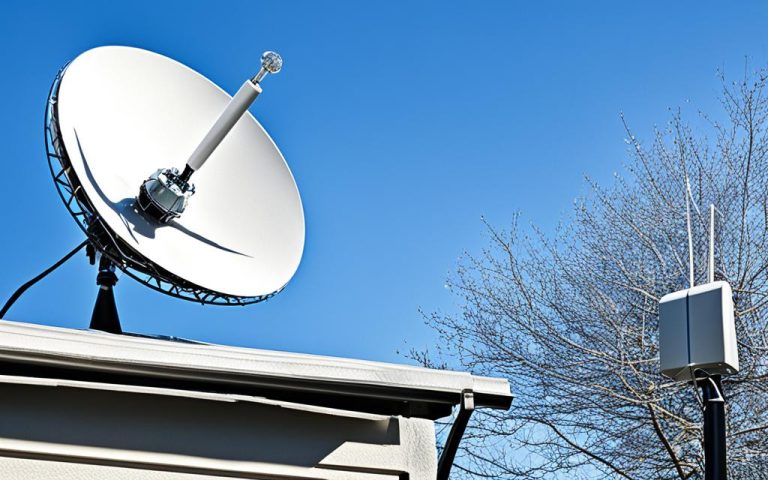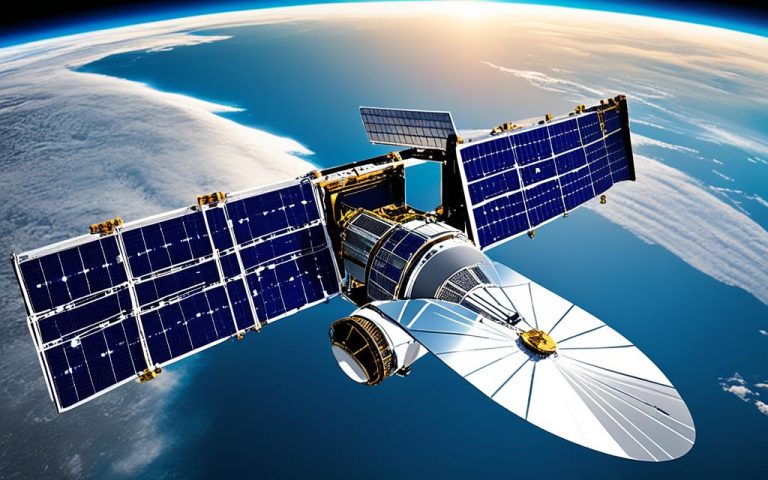Artificial intelligence (AI) has emerged as a game-changer in the field of satellite networks. It offers the potential to optimize network operations and extract valuable insights for analysis. By employing AI algorithms and machine learning techniques, satellite networks can achieve enhanced efficiency and accuracy.
With the ability to handle large volumes of observations, AI can improve modeling and analysis, leading to more accurate forecasts and predictions. The application of AI in various industries has proven its worth, and when applied in satellite networks, it holds immense promise.
Through the utilization of machine learning, a subset of AI, satellite networks can experience significant advancements. Machine learning models trained with extensive datasets can accurately analyze and interpret observations from satellite sensors, resulting in faster computations and improved network optimization.
The advantages of AI in satellite network management are numerous. AI algorithms enable the efficient processing and handling of large volumes of data, driving overall network performance. Automation of monitoring and troubleshooting tasks frees up resources and increases productivity.
AI also has the potential to discover new relationships within vast datasets and correct model forecasts. This enhances the quality of satellite network operations and empowers decision-makers with valuable insights.
While the integration of AI in satellite network optimization presents challenges such as big data handling and technical maturity, opportunities abound. AI can revolutionize satellite data processing, data assimilation, model physics, and postprocessing.
Integrating AI into satellite communications (SATCOM) brings added benefits. Cloud computing and AI offer scalability, flexibility, security, and cost-effectiveness in SATCOM operations. AI can optimize network configuration and routing based on real-time data, reducing latency and interference. It also automates processes, increasing productivity and accuracy.
Considering the impact on SATCOM performance and addressing potential risks, such as data security concerns, is crucial for successful AI integration. Evaluating the benefits and considerations ensures that AI is effectively harnessed in the management of satellite networks.
In conclusion, the potential of AI in satellite network optimization and analysis is vast. By leveraging machine learning and AI algorithms, satellite networks can achieve improved efficiency, advanced data processing, and enhanced forecasting capabilities. AI has the power to revolutionize communication system management, making it a significant asset in the satellite network industry.
The Role of Machine Learning in Satellite Networks
Machine learning, a subset of AI, plays a crucial role in improving satellite networks. By training machine learning models with large datasets, algorithms can accurately analyze and interpret observations from satellite sensors. This leads to faster and more accurate computations, enabling efficient optimization of satellite network operations.
Machine learning algorithms can also be applied in areas such as satellite data preprocessing, data assimilation, and forecast postprocessing, enhancing the overall performance of satellite networks. These algorithms can handle complex data patterns, identify anomalies, and make predictions based on historical data, providing valuable insights for network optimization.
“Machine learning algorithms enable satellite networks to adapt and learn from new data, allowing for continuous improvement of network performance and efficiency.”
One of the key advantages of machine learning in satellite networks is its ability to automate complex tasks. Algorithms can autonomously analyze vast amounts of data, reducing the need for manual intervention and enabling real-time decision-making.
Moreover, machine learning algorithms can enhance data assimilation processes by efficiently combining satellite observations with numerical models, improving the accuracy of forecasts. By leveraging machine learning techniques, satellite networks can overcome data uncertainties, model errors, and other challenges commonly encountered in network optimization.
Overall, machine learning plays a pivotal role in satellite networks by leveraging the power of AI to accurately analyze data, optimize operations, and provide valuable insights for network performance enhancement.
Advantages of AI in Satellite Network Management
AI brings numerous advantages to the management of satellite networks. With AI algorithms, satellite networks can process and handle large volumes of data more efficiently, improving overall network performance. AI can automate processes and tasks, such as monitoring and troubleshooting, freeing up resources and increasing productivity. Additionally, AI can help discover new relationships in large datasets and correct model forecasts. These advantages enhance the quality of satellite network operations and enable better decision-making.
| Advantages of AI in Satellite Network Management |
|---|
| Efficient data processing and handling |
| Automation of monitoring and troubleshooting |
| Discovery of new relationships in large datasets |
| Improvement of model forecast accuracy |
| Enhanced overall network performance |
Efficient Data Processing and Handling
By leveraging AI, satellite networks can process and handle large volumes of data more efficiently. AI algorithms can analyze and interpret data at a rapid pace, enabling real-time decision-making and providing valuable insights. This improved data processing capability enhances the overall performance of satellite networks.
Automation of Monitoring and Troubleshooting
AI allows for the automation of various processes and tasks in satellite network management, including monitoring and troubleshooting. With AI algorithms continuously monitoring network performance, issues can be identified and resolved promptly, minimizing downtime and optimizing network operations.
Discovery of New Relationships in Large Datasets
One of the key advantages of AI in satellite network management is its ability to discover new relationships in large and complex datasets. By applying machine learning algorithms, AI can uncover hidden patterns and correlations, enabling network operators to gain valuable insights and make data-driven decisions.
Improvement of Model Forecast Accuracy
AI can significantly improve the accuracy of model forecasts in satellite network management. By analyzing historical data and continuously learning from new observations, AI algorithms can refine and correct forecasting models, leading to more reliable predictions. This enhanced forecast accuracy is crucial for effective decision-making and optimizing network operations.
Enhanced Overall Network Performance
By harnessing the power of AI, satellite network management can achieve enhanced overall performance. With efficient data processing, automated monitoring, and improved forecasting, the network can operate more efficiently, delivering better communication services and ensuring improved user experiences.
To further illustrate the advantages of AI in satellite network management, refer to the Advantages of AI in Satellite Network Management table below:
| Advantages of AI in Satellite Network Management |
|---|
| Efficient data processing and handling |
| Automation of monitoring and troubleshooting |
| Discovery of new relationships in large datasets |
| Improvement of model forecast accuracy |
| Enhanced overall network performance |
Challenges and Opportunities in Satellite Network Optimization
While AI offers great potential for satellite network optimization, there are also challenges to overcome. One of the major challenges is handling big data, as satellite networks generate a vast amount of environmental observations. Efficient data preprocessing and analysis techniques are essential to fully exploit these observations. Another challenge is the technical maturity and severe latency requirements of global numerical weather prediction (NWP) models.
Handling Big Data:
The sheer volume of data generated by satellite networks presents a significant challenge. To effectively leverage the abundance of environmental observations, efficient data preprocessing and analysis techniques must be implemented. This includes data cleaning, filtering, and extraction of relevant information. By applying AI algorithms in data preprocessing, satellite networks can optimize their operations and extract valuable insights.
Technical Maturity and Latency Requirements:
The technical maturity of global numerical weather prediction (NWP) models poses a challenge in satellite network optimization. NWP models require low latency and high computational power to deliver accurate forecasts. AI can address this challenge by enhancing model physics, improving data assimilation, and facilitating postprocessing of numerical model outputs. By integrating AI techniques, satellite networks can achieve higher accuracy and efficiency in forecasting.
Despite these challenges, there are significant opportunities to leverage AI in satellite network optimization:
- Improving Satellite Data Processing: AI algorithms can enhance satellite data processing by automating tasks such as data cleaning, pattern recognition, and anomaly detection. This streamlines the data analysis process and enables faster insights.
- Facilitating Data Assimilation: AI provides the ability to assimilate diverse sets of satellite data with other observational data, improving the accuracy and reliability of models.
- Enhancing Model Physics: AI techniques can optimize model physics and parameterizations, ensuring more accurate simulations and forecasts.
- Enhancing Postprocessing of Numerical Model Outputs: AI algorithms can analyze and interpret numerical model outputs, providing valuable postprocessed information for decision-making in satellite network optimization.
By tapping into these opportunities, satellite network optimization can benefit from the power of AI, enabling more efficient operations and improved forecasting capabilities.

Opportunities for AI in Satellite Network Optimization
| Opportunities | Benefits |
|---|---|
| Improving data processing | Automates data cleaning, pattern recognition, and anomaly detection |
| Facilitating data assimilation | Enhances the accuracy and reliability of models by incorporating diverse satellite and observational data |
| Enhancing model physics | Optimizes model simulations and improves forecast accuracy |
| Enhancing postprocessing of numerical model outputs | Provides valuable information for decision-making and optimization |
Benefits and Considerations of AI Integration in SATCOM
Integrating AI into satellite communications (SATCOM) brings numerous benefits that can revolutionize operations. From cloud computing to AI algorithms, SATCOM stands to gain scalability, flexibility, security, and cost-effectiveness in its operations.
One of the significant advantages of AI integration is its ability to optimize network configuration and routing based on real-time data. By analyzing data and making intelligent decisions, AI can reduce latency and interference, ultimately improving network performance in SATCOM.
In addition to optimizing network performance, AI can automate processes and tasks, enhancing productivity and accuracy within SATCOM operations. This automation allows for efficient resource allocation, freeing up valuable human resources to focus on more critical tasks.
However, when integrating AI into SATCOM, there are certain considerations that must be taken into account. Data accessibility and privacy are key concerns. Ensuring that data can be accessed securely and protecting the privacy of sensitive information is crucial for successful AI integration.
Evaluating the impact of AI on SATCOM performance is essential. It is necessary to determine how AI implementation will affect existing systems and processes, and any potential risks that might arise, such as data security concerns.
To fully understand the benefits and considerations of AI integration in SATCOM, a comprehensive approach is required. By prioritizing data accessibility, privacy, and performance evaluation, SATCOM can leverage the power of AI to optimize its operations and achieve significant advancements in the field.
Conclusion
The integration of artificial intelligence (AI) in satellite networks has the potential to revolutionize optimization and analysis in communication systems. By leveraging the power of machine learning algorithms, satellite networks can be optimized for efficiency and provide valuable insights for decision-making.
While there are challenges to overcome, such as effectively handling big data and ensuring technical maturity, the benefits of AI integration in satellite networks are significant. AI algorithms enable the processing and analysis of large volumes of data, enhancing overall network performance.
AI also brings automation to satellite network management, facilitating tasks like monitoring, troubleshooting, and forecasting. Through AI integration, satellite networks can improve data processing, model physics, and numerical forecast outputs, leading to more accurate predictions and optimized operations.
In conclusion, AI is a game-changer in satellite network optimization and analysis. By harnessing the power of machine learning and AI algorithms, satellite networks can achieve advanced communication system management. As the technology continues to advance, the potential for AI in satellite networks is vast, unlocking new possibilities for efficiency, innovation, and improved satellite network performance.
FAQ
What is the potential of AI in satellite network optimization and analysis?
AI has the potential to revolutionize the way we manage satellite networks by leveraging AI algorithms and machine learning techniques. It can optimize satellite networks for efficiency and provide valuable insights through analysis of large volumes of data.
What role does machine learning play in improving satellite networks?
Machine learning, a subset of AI, plays a crucial role in improving satellite networks by training models with large datasets. This allows for accurate analysis and interpretation of observations from satellite sensors, leading to faster and more accurate computations and optimization of network operations.
What are the advantages of AI in satellite network management?
AI algorithms enable satellite networks to process and handle large volumes of data more efficiently, improving overall network performance. AI can automate processes and tasks, freeing up resources and increasing productivity. Additionally, it can help discover new relationships in large datasets and enhance forecast accuracy, enabling better decision-making.
What are the challenges and opportunities in satellite network optimization?
One major challenge is handling big data generated by satellite networks, requiring efficient data preprocessing and analysis techniques. Another challenge is the technical maturity and latency requirements of global numerical weather prediction models. However, there are significant opportunities to leverage AI in satellite network optimization, including improving data processing, facilitating data assimilation, enhancing model physics, and enhancing postprocessing of numerical model outputs.
What are the benefits and considerations of AI integration in SATCOM?
Integrating AI into satellite communications (SATCOM) offers scalability, flexibility, security, and cost-effectiveness. AI can optimize network configuration and routing based on real-time data, reducing latency and interference. It can also automate processes and tasks, increasing productivity and accuracy. However, considerations such as data accessibility and privacy must be addressed when integrating AI into SATCOM.
How does AI revolutionize satellite network optimization and analysis?
By leveraging machine learning and AI algorithms, satellite networks can be optimized for efficiency and analyzed for valuable insights. Despite challenges such as handling big data and ensuring technical maturity, the benefits of AI integration in satellite networks are significant, improving data processing, forecasting capabilities, and overall communication system management.



















